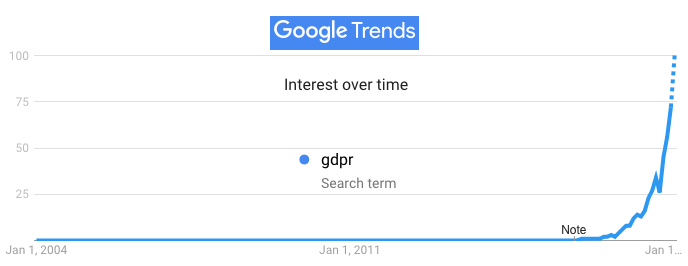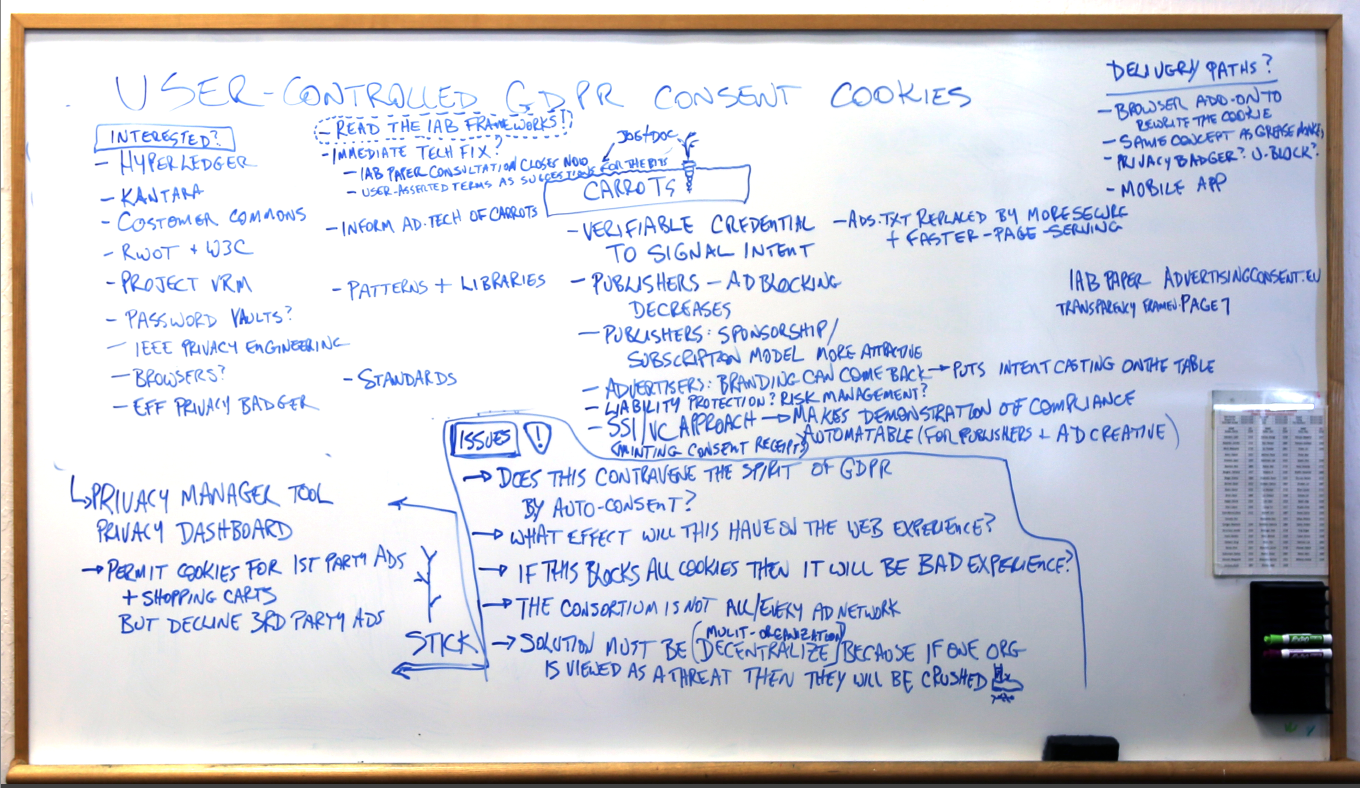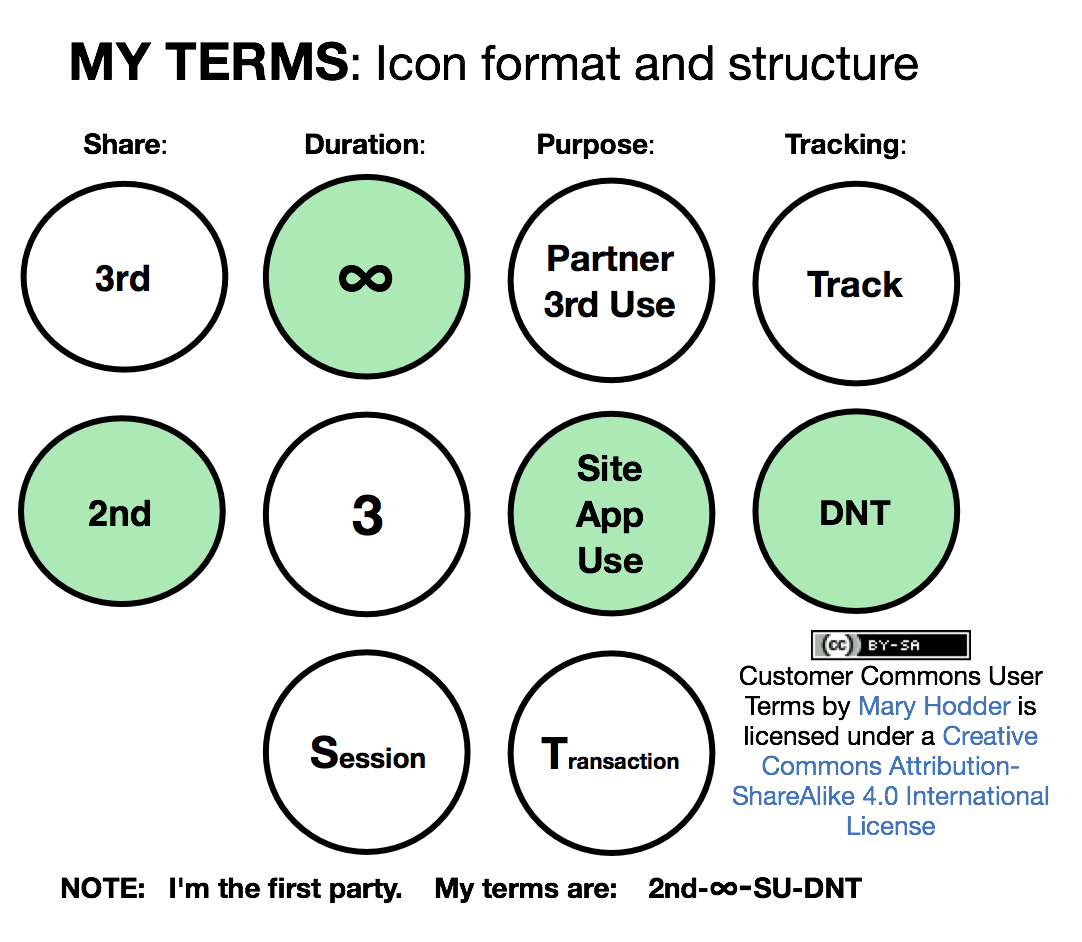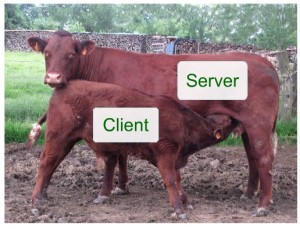“Social networks” are getting out of control. And I don’t mean their control. I mean your control and mine. Here’s an image to keep in mind while you read the rest of this post:

The calf is you or me. The cow is just one of our many social networks. Here’s how the situation looks from my browser…
- I have 840 contacts on Facebook. I won’t call them friends, though some of them are. A few are relatives, but most are neither. They’re people I’ve met or had contact with, somehow, somewhere. I also have 675 “friend requests.” If you’re on that list and want to contact me, find another way, since I avoid Facebook for all but the unavoidable (such as, say, a reunion that’s being organized by relatives).
- I have 480 contacts on Linkedin, most of which I know about as well as my contacts on Facebook. I also belong to one Linkedin discussion group that I haven’t figured out how to deal with yet, mostly because I prefer my discussion groups in email, where I can sort them out into boxes of my own making. I see that Linkedin now also has updates on the Twitter model (and via Twitter). I see why they do it, but I don’t need it.
- I have 212 contacts on Flickr (plus more through three other accounts). I don’t know and don’t follow most of those contacts, because to me Flickr is is for sharing photos with the world in organized ways. While I appreciate the groups there, I’ve organized none, and when my photos show up in some, it’s always because other people — most of which I don’t know — have put them there. I also know few if any of the people who have put more than 200 of my photos on Wikimedia Commons, a gallery of photos eligible for inclusion in Wikipedia articles. (And, in fact, most of my shots in the Commons are also in Wikipedia.) Again, this is not a social effect. Also note that in the Wikipedia case that there isn’t a business model anywhere in sight (aside from the $50/year I gladly pay for my two “pro” Flickr accounts).
- I follow 1352 entities (most are people, some are companies or organizations) on Twitter, and am followed by 13,096 others. I am sure most of us, whoever (and whatever) we are, don’t know each other. I use Twitter to find and share interesting stuff in short postings. This may be “social,” but only in a very loose sense.
- I don’t know how many “friends” or contacts I have on Google, because I can’t find a number, or a list. My iGoogle page (which I view in just one of the four browsers I use) lists eight alphabetically before it runs out out of space at the letter N. I don’t know how to scroll down to see the rest, and I’m not much interested in trying. In any case the number is a tiny subset of lists elsewhere. For what it’s worth, I use Google’s services for many different things (docs, self-organized groups, mail de-spamming), but “social” stuff is not among them.
- The address book on my computer lists 1162 cards, including a growing number of dead people, dead companies, and dead numbers from live companies. Yesterday I weeded the number of Verizon contact numbers down from six to one.
- My main chat client, which spans four different contact lists and accounts (AIM-iChat, Google, Linux Journal and the Berkman Center), currently shows 35 available. I don’t know what the total number of contacts there is. Several hundred, I guess.
- My other chat account, Skype, doesn’t integrate with those in the last paragraph and doesn’t give me a count of people online and off. I’m guessing I have about fifty contacts there.
The job of integrating all of these is mine, and I don’t bother, because the tools for doing that don’t yet exist — at least not in sufficient maturity for me to contemplate using them. Thus I am not yet what Joe Andrieu calls the point of integration for my own data. In fact I can’t be, because most of the data in these “social networks” is not mine. Functionally (if not also legally), it’s theirs. And I’m just a calf for each of them.
Of course, all these companies want to help me do everything, by leveraging the “social” data they have about me. Mostly they give me advertising that doesn’t help, but sometimes they just try to improve their meat and potatoes with “social” gravy. The latest example is Google, with “+1” recommendations. These augment Google’s third improvement to social search, through a button“to publicly give something your stamp of approval.” The idea: “Your +1′s can help friends, contacts, and others on the web find the best stuff when they search,” because “sometimes it’s easier to find exactly what you’re looking for when someone you know already found it.”
Why does Google think we want to “find the best stuff” all the time — as if all we do is shop, or something like it? Sure, they make their money with advertising, but I think the real reason is that they can’t resist the temptation to route “social” signals into everything else. Hey, it’s what the other kids are doing.
Since so much of what those kids do is invisible to us, they try to get away with all kinds of stuff. For more on what they’re doing, read The Wall Street Journal‘sWhat They Know series http://wsj.com/wtk), and Joe Andrieu’s ISharedWhatFacebook login simulation site, which shows you how much personal data — yours and your friends’ — might get spilled every time you click on one of these:

They get away with it because the calf-cow system allows it. Also because the World Wide Ranch is getting really freaking huge. By some counts there are more than a billion commercial sites on the Web. Just by the sheer numbers involved, the default assumption is that most searches have commercial purposes. That’s what you’re likely to find in any case.
It’s interesting that non-advertising search results are now called “organic,” as if they were some kind of marginalized exception, of interest only to to a few obsessive purists.
Says Wikipedia, “Organic search results are listings on search engine results pages that appear because of their relevance to the search terms, as opposed to their being advertisements. In contrast, non-organic search results may include pay per click advertising.” How quaint and retro, to think that some search results should simply be relevant to search terms, without commercial prejudice by the search engine.
In respect to Google’s recent search improvements, I submit that organic searches are still what people want most, and that “social” help is marginal at best and distracting at worst.
Take yesterday morning, when I was wondering what accounts for ground conductivity. This was, admittedly, an idle distraction of the sort I wrote about later in the day, in World Wide Puddle. I mean, I didn’t really need to know what accounts for ground conductivity, especially since it’s a question I’ve had for about fifty years, and I haven’t suffered for lack of an answer. But search engines are here for a reason, so I looked again.
Google says it finds more than six million results in a search for “ground conductivity”. The top result is the FCC’s M3 maps page, which I’d expect. These maps explain why, for example, WNAX, a 5000-watt radio station on 570am in Yankton, South Dakota, has a signal that reaches from Canada to Oklahoma, while WWNC, a station on the same channel in Asheville, North Carolina, operating with the same power, covers an area only a fraction the size of WNAX’s. For a broadcast engineering junkie like me, this is catnip, but it doesn’t explain why ground conductivity varies from one region to another. I mean, why does flat ground in Long Island have almost no ground conductivity (0.5 mhos/meter) while equally flat ground around Dallas has very high ground conductivity (30 mhos/meter). Why do mountains in New England have low conductivity (2-4 mhos/meter) while mountains in coastal California have high conductivity (8-30 mhos/meter)? The M3 maps don’t say.
In the second result, Wikipedia says “Ground conductivity refers to theelectrical conductivity of the subsurface of the earth.” But that’s about it.
The third result, from Tom K1JJ, tells how to measure ground conductivity, but doesn’t explain the cause.
Next is a Facebook page on the subject, with a write-up lifted straight out of Wikipedia. It is recommended to me, with thumbs up, by two people I know: a nephew of mine and a fellow broadcast engineering obsessive. There is no discussion, and the page says “0 people like this”.
Two decades ago, when Compuserve hosted a large variety of excellent forums, I belonged to a broadcast engineering social network of sorts (though few of us met in real life). But today I don’t have one, even on Facebook — and the rest of my many “social networks” are no help with searches like this one.
Hmm… I just thought, “maybe Quora could provide some help. I just went there in the browser where Quora’s cookies for me are parked. It still wants me to log in, and a minute has passed while the progress thing on the bottom of the page says “Waiting for Facebook.” Okay, I’m there now, and I just put up the question, “What causes ground conductivity?”. According to Quora, I have “981 Followers, 485 Following” and “6 @Mentions” there. Will one or more of them get me an answer? Interesting experiment. We’ll see.
Whatever happens on Quora, I have no faith that my searches on Google will be improved by anybody’s “+1,” any more than my searches have been improved by “social” whatever. Here’s why: usually I’m looking for something very specific. And often what I’m looking for is not for sale.
In most cases I use Google and Bing the way I use a dictionary: to look something up. I don’t need a “recommendation” when I just want to know how to spell “mocassin”. Stand back, everybody. I think the dictionary should have it. Thank you.
I learned about Google’s “+1″ feature only this morning, on Sheila Lennon’s blog. There she quotes the same Google post about “+1″:
So how do we know which +1’s to show you? Like social search, we use many signals to identify the most useful recommendations, including things like the people you are already connected to through Google (your chat buddies and contacts, for example). Soon we may also incorporate other signals, such as your connections on sites like Twitter, to ensure your recommendations are as relevant as possible. If you want to know who you’re connected to, and how, visit the “Social Circle and Content” section of the Google Dashboard.
To get started +1’ing the stuff you like, you’ll need to create a Google profile—or if you already have one, upgrade it. You can use your profile to see all of your +1’s in one place, and delete those you no longer want to recommend. To see +1’s in your Google search results you’ll need to be logged into your Google Account.
I just clicked on the Google Dashboard link, and found I had to log in, even though I was already logged in on a different tab in the same browser. This got me into my Google Accounts page, which has a LOT of information in a lot of contexts — all provided by Google. At the top is Gmail. Slightly edited (for the privacy of others), and with links removed, it says,
Gmail
Inbox 5000 conversations
Most recent: [18] new discussions, [15] new comments… at 9:22 AM
All mail 5000 conversations
Most recent: [18] new discussions, [15] new comments… at 9:22 AM
Sent mail 70 conversations
Most recent: ____ on Mar 31, 2011
Saved drafts 46 conversations
Most recent: progress & title on Mar 9, 2011
Chat history 60 conversations
Most recent: Chat with __________ on Mar 11, 2011
Spam 17000 conversations
Most recent: Copy of a Gucci watch is what you need … at 9:40 AMTrash 60 conversationsMost recent: Re: Sharing my TEDx Talk: The Unclear Path at 11:01 PM
First, I almost never go to Gmail in a browser. In fact, few people know my actual Gmail address (which is silly and has nothing to do with my real name). All mail to me at Searls.com gets routed to my Gmail account, which I use to filter out spam. I then pick up mail there from my IMAP account, which keeps copies at the server, or “in the cloud” as we now like to say.
Second, what makes Spam or Trash “conversations”? I’ll go to my grave being known as the main guy responsible for the “markets are conversations” meme, but usage like this makes me regret it.
Following Gmail on my Accounts page are:
So I just spent twenty minutes weeding through and cleaning up all that stuff. I could spend similar sums of time doing the same on Linkedin, Flickr and other services. But I would rather have my own way of keeping personal information straight with myself, and sharing it selectively and when I felt like it. That’s what VRM development going on in the Personal Data Ecosystem is about. I won’t go into all the projects, but the idea they share is that each of us, as sovereign individuals, are (as Joe says) the best points of integration for our own data. None of these social sites, no matter how well-intended they may be, can do the job, simply because nothing, and nobody, can be personal for me on my behalf. If puppets are involved, they need to be mine. Not the reverse.
At the Kynetx Impact conference two weeks ago (where much fun was had),Louis Gray gave an interesting talk that summarized what he said last November, in a post perfectly titled
The Third Wave of the Web Will Be Uniquely Personal. He writes about three waves. The first is “information and access” — roughly what I’ve called the “static Web.” The seond is “social.” That’s the stage we’re getting fed up with now. The third is personal:
Now that the world’s information is posted, linked, indexed and searchable, and friends are connecting, sharing, liking, and following, the quest is on to streamline the noise and give the Web another dimension – one not measured by the data, or who led you to the data, but you as an individual. The third wave of the Web, I believe, is going to be about personalization by individual based on that individual’s preferences – explicitly stated or otherwise.
The declaration of the next wave of the Web being personal is not shared universally, of course. Some say the next wave is all about mobile. Others may say the next wave is all about location. But the right approach to ‘personal’ absolutely encompasses each of these things. With our smartphones and tablets being increasingly powerful, they are practically an extension of us, and we are relying on them to discover relevant things, content, places and products for us as individuals. Similarly, our location is an ingredient of who we are – for where we are impacts our decisions, and what tips are relevant, be it for news, for restaurants, lodging, dating or anything else. So “personal” as an individual is both local and mobile.
Excellent. I especially like how smartphones and tablets are extensions of ourselves in the world. (A little more about that here.) Then he adds,
Personal As In Me.
A lot of services say they are “personal”, when in fact, most of what they do is actually social.
These services may leverage your social graph to provide personalized recommendations based on what friends or other people similar to you may like – much like television shows group people of similar demographics to guess what commercials are best suited for which episodes in which time slots. The hope may be that the more your friends like something, the more likely you are to click it or buy it. Peer pressure, you know. Meanwhile, other services say they are personal because you have specifically provided them with information about you and what you like, which goes partway to discovering your interests, but is incomplete, and possibly inaccurate, as you may want to indicate that you are something that you are not, or you may have overlooked some of your own interests in the name of rapid completion.
Beyond these initial attempts is a new wave of companies trying to crack the code of the real you. Of course, my6sense is one of those companies. Our goal is to deliver a personalized experience in all possible aspects of your life, finding the right information for you at the right time in the right context, based on you as an individual. But we are not alone. Take, for example, Hunch.com, which is talking about personalizing the Internet, and says they can build a taste profile for you, based on your own unique interests and tastes. Also, in October, Mike Arrington of TechCrunch previewed Gravity, founded by former MySpace executives. In that piece, which he headlined as “The Personalization War”, he said “I saw my own Interest Graph based only on my Facebook and Twitter streams over the last several months and it’s scary-accurate.”
Louis doesn’t go off the personal rails here. He just doesn’t quite get on, staying instead on the corporate ones:
Which makes sense:
My6sense is his company. Then finally,
The continuing rapid growth of information creation and sharing, combined with pervasive connectivity, increased capability of smartphones and other mobile devices and the growth of location is all pointing us into a direction where the services on the other end have more potential to know you than those of years past, and you have the ability to be inspired by the right information in the right place more than ever before. This is a wave, one that benefits from all these mega-changes in the Web, that small companies and big ones alike are seeing. Maybe there’s another big winner in there, just like there was in the last two. Regardless, the direction is clear. Show me my Web for me.
Sorry, but no. My Web is not their Web. I’m tired of being shown. I’m tired of “experiences” that are “delivered” to me. I’m tired of bad guesswork — or anyguesswork. I don’t want “scarily accurate” guesses about me and what I might want.
What I crave is independence, and better ways of engaging — ones that are mine and not just theirs. Ones that work across multiple services in consistent ways. Ones that let me change my data with all these services at once, if I want to.
I want liberation from the commercial Web’s two-decade old design flaws. I don’t care how much a company uses first person possessive pronouns on my behalf. They are not me, they do now know me, and I do not want them pretending to be me, or shoving their tentacles into my pockets, or what their robots think is my brain. Enough, already.
I spoke at Kynetx Impact the night before Louis’ talk. The visuals are on Slideshare. Here is slide 25, which illustrates the problem with the commercial Web’s long-defaulted client-server design:
 Wikipedia says, “The client–server model of computing is a distributed application structure that partitions tasks or workloads between the providers of a resource or service, called servers, and service requesters, called clients.”
Wikipedia says, “The client–server model of computing is a distributed application structure that partitions tasks or workloads between the providers of a resource or service, called servers, and service requesters, called clients.”
So, while the Net itself has an end-to-end design, in which all the ends are essentially peers, the Web (technically an application on the Net) has a submisive-dominant design in which clients submit to servers. It’s a calf-cow model. As calves, we request pages and other files from servers, usually getting cookie ingredients mixed in, so the cow can remember where we were the last time we suckled, and also give us better services. Especially advertising.
We have no choice but to agree with this system, if we want to be part of it. And, since the cows provide all the context for everything we do with them, we have onerous “agreements” in name only, such as what you see on your iPhone every time Apple makes a change to their store:

Legal folks call these “contracts of adhesion.” Sez the Free Dictionary,
A type of contract, a legally binding agreement between two parties to do a certain thing, in which one side has all the bargaining power and uses it to write the contract primarily to his or her advantage.
An example of an adhesion contract is a standardized contract form that offers goods or services to consumers on essentially a “take it or leave it” basis without giving consumers realistic opportunities to negotiate terms that would benefit their interests. When this occurs, the consumer cannot obtain the desired product or service unless he or she acquiesces to the form contract.
Here’s the thing: client-server’s calf-cow model requires this kind of thing, because the system is designed so the server-cows are in complete control. You are not free. You are captive, and dependent.
This system has substantiated a business belief that has been around ever since Industry won the industrial revolution: that a captive customer is more valuable than a free one. We’ve built systems that tendentiously affirm that belief, and the commercial Web is chief among those systems today. Correspondingly, on the customer side, we actually believe that a free market is your choice of captor. Even champions of the free market, such as The Wall Street Journal, seem to think this is okay. (Or they wouldn’t keep talking about how telecom giants — occupants of a regulatory zoo they all but own and control — comprise the “free market” at work.)
If the next wave is personal, then we have to bring our own contexts.
Think for a moment about the context of renting a wheelbarrow. If you sign an agreement for that, it’s only to put up a deposit, pay a certain amount, assume liability for whatever harms you might cause with it, and return the thing in good condition. That’s about it.
Or think about what happens when you walk into a shoe store. You don’t have to sign a damn thing. (If you’re lucky, the store won’t require that you belong to their “loyalty” program just to get a “discount” that’s nothing more than a normal price, rather than a higher price they charge to punish non-”members”.) Your context is shopping for shoes. Laws apply, of course. You aren’t allowed to steal things or act in a disturbing way. But nobody stands at the door telling you to stop and sign an agreement — least of all one with clauses (which nearly all adhesive contracts have) saying they have the right to change the terms, and they can do that whenever they please.
We won’t get rid of calf-cow systems, nor should we. They work, but they have their limits, and those become more apparent with every new calf-cow service we join. But we can work around these things, and supplement them with other systems that give us equal power on equal footings, including the ability to proffer our own terms, express our own preferences and policies, and make independent choices.
Louis Gray’s personal wave is for real, and it’s just starting. It’s also what we’ve been building through the last four years with ProjectVRM. And it’s starting to catch on. The number and variety of VRM development projects has grown a lot lately, as has the activity level as well.
Naturally, VRM has attracted the interest of major players on the sell side of the marketplace. A month ago I spoke on stage with John Battelle on stage at the Internet Advertising Bureau conference. (John’s insightful post about “digital plumage” ran in the same timeframe.) Next week I’ll speak at SugarCon in San Francisco and to a meeting with Best Buy and General Mills in Minneapolis. It’ll be fun.
The message I’m bringing is not about how these companies can improve the cow systems everybody has done so much to build and improve already. It’s about how buyers and sellers are no longer just cattle, and how we now need to prove something we’ve known all along: that free customers are more valuable than captive ones.








 b. Undertaken on an individual basis: private studies; private research. c. Of, relating to, or receiving special hospital services and privileges: a private patient.
b. Undertaken on an individual basis: private studies; private research. c. Of, relating to, or receiving special hospital services and privileges: a private patient.














